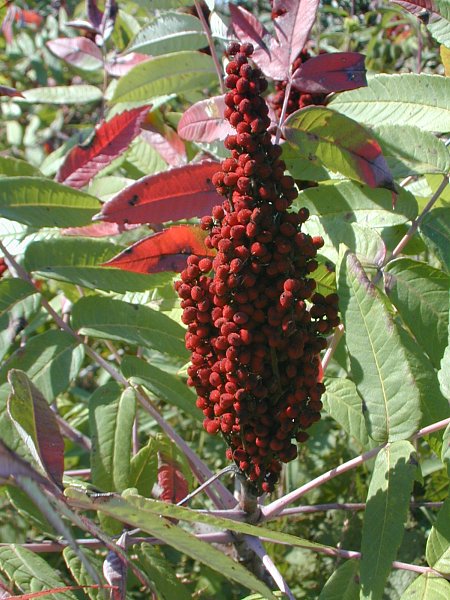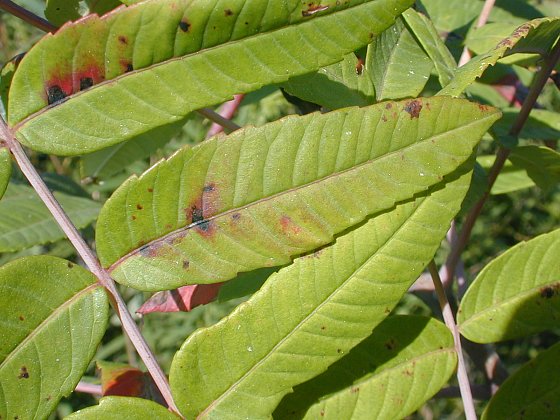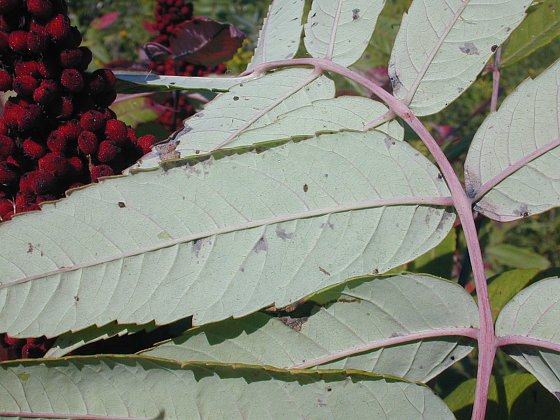Description: This shrub is usually 3-10' tall, although occasionally it is up to 20' tall. It typically has a single trunk and several leafy branches. On older mature shrubs, trunk bark is brownish gray, horizontally fissured, and slightly warty, while the bark of major branches is brownish gray to reddish brown and more smooth. Alternate compound leaves occur along the branches and young shoots; they are odd-pinnate with 9-31 leaflets and deciduous. Individual leaflets are up to 4½" long and 1" across; they are narrowly lanceolate or oblong-lanceolate in shape, serrated along their margins with low blunt teeth, and sessile. The upper leaflet surface is yellowish green to dark green and hairless, while the lower leaflet surface is whitened, hairless, and glaucous. Leaflet venation is pinnate. The rachises (central stalks) and petioles of the compound leaves are whitish pale red to whitish pale purple, and glaucous. During the autumn, the leaflets become brilliant red or dark red. The upper branches terminate in more or less erect panicles of flowers that are up to 1¼' long and ¾' across; the peduncles (basal stalks) of these panicles are up to 6" long and stout.

Because Smooth Sumac (Rhus glabra) is dioecious, individual shrubs produce either all male (staminate) or all female (pistillate) flowers. Regardless of gender, individual flowers are a little less than ¼" across, consisting of a yellowish green or whitish green corolla with 5 spreading lobes and a green calyx with 5 teeth. Both the lobes the corolla and teeth of the calyx are lanceolate to ovate in shape. In addition, individual male flowers have 5 stamens, while individual female flowers have an ovary with 3 styles. The stout branches of the panicle are light green and usually pubescent. The blooming period occurs from late spring to mid-summer, lasting about 2-3 weeks. On female shrubs, the flowers are replaced by drupes that become mature during the autumn and often persist into the winter. Individual mature drupes are a little less than ¼" across and more or less globoid in shape; they are brilliant dark red and densely covered with short acrid hairs, fading gradually to black during the winter. The fleshy interior of each drupe contains a single stony seed that is straw-colored (stramineus) and smooth along its surface. The root system is highly rhizomatous, often producing colonies of clonal shrubs.

Cultivation: The preference is full to partial sun, moist to dry conditions, and soil containing loam, clay-loam, gravelly material, or rocky material. With the possible exception of Staghorn Sumac (Rhus hirta), this sumac tolerates soil with a higher pH than other sumac shrubs (Rhus spp.) within Illinois. Smooth Sumac develops rapidly, but individual shrubs are short-lived. Nonetheless, it can spread aggressively and persist in a given area because of the formation of clonal offsets from its rhizomes.
Range & Habitat: The native Smooth Sumac occurs in every county of Illinois; it is a common plant (see Distribution Map). Habitats include prairies, edges of prairies, edges of hill prairies, open woodlands with a history of disturbance, savannas, thickets, woodland borders, limestone glades, fence rows, areas along railroads, roadside embankments, and waste places. Smooth Sumac is one of the shrubby invaders of prairies; it is a pioneer species that thrives on disturbance. Because of its extensive root system, it is able to recover from occasional wildfires or mowing.

Faunal Associations: Nectar is available as a floral reward from female shrubs, while both nectar and pollen are available as floral rewards from male shrubs to insect visitors. These flower-visiting insects include honeybees, bumblebees, little carpenter bees (Ceratina spp.), large carpenter bees (Xylocopa virginica), armored-resin bees (Heriades spp.), Halictid bees (including green metallic bees), plasterer bees (Colletes spp.), Andrenid bees (Andrena spp.), masked bees (Hylaeus spp.), Sphecid wasps, Eumenine wasps, soldier flies (Stratiomys spp.), Syrphid flies, Tachinid flies, bee flies (Bombyliidae), thick-headed flies (Conopidae), flesh flies (Sarcopidae), Muscid flies, butterflies, and miscellaenous beetles (Robertson, 1929; Smith et al., 2012; Krombein et al., 1979; Kopper et al., 2001; O'Brien, 1989). Little carpenter bees also construct nests for their larvae by tunneling into the pith of twigs. Other insects feed on the leaves, wood, sap, and other parts of Smooth Sumac and other sumac shrubs (Rhus spp.). These insect feeders include larvae of the Sumac Stem Borer (Oberea ocellata) and other long-horned beetles, the Sumac Flea Beetle (Blepharida rhois), Lupine Bug (Megalotomus quinquespinosus), Clouded Plant Bug (Neurocolpus nubilus) and other plant bugs, Sumac Gall Aphid (Melaphis rhois) and other aphids, treehoppers, larvae of the Scarlet Sawfly (Arge coccinea), larvae of a butterfly, the Red-banded Hairstreak (Calycopis cecrops), and larvae of such moths as the Showy Emerald (Dichorda iridaria), Dark Marathyssa (Marathyssa inficita), Sumac Paectes (Paectes abrostolella), and Regal Moth (Citheronia regalis). The Insect Table provides a more complete list of these species. Vertebrate animals also use Smooth Sumac and other sumac shrubs as sources of food, especially the fruits. Many species of birds eat the fruits from autumn to spring, including the Cedar Waxwing, Yellow-rumped Warbler, Red-bellied Woodpecker, Dark-eyed Junco, Ring-necked Pheasant, Wood Thrush, Northern Mockingbird, and Warbling Vireo. The Bird Table provides a more complete list of these species. The White-tailed Deer occasionally browses on the foliage, twigs, and fruits of these shrubs, while the Cottontail Rabbit gnaws on the bark during the winter (Martin et al., 1951/1961; Myers et al., 2004; Sotala & Kirkpatrick, 1973). Smooth Sumac and other sumac shrubs provide nesting habitat for the Field Sparrow and other birds (Best, 1978). Because they often form dense colonies, these shrubs provide signficant protective cover for many kinds of wildlife.

Photographic Location: Photographs were taken at a remnant prairie along a railroad near Champaign, Illinois, and at Meadowbrook Park in Urbana, Illinois.
Comments: Smooth Sumac (Rhus glabra) is an attractive shrub during the autumn because of its hairy red fruits and bright red foliage. Among other sumac species (Rhus spp.) in Illinois, Smooth Sumac can be distinguished by the absence of hairs on its stems and leaf rachises, the absence of winged leaf rachises, and the number of leaflets on its compound leaves. In contrast, Staghorn Sumac (Rhus hirta) has brownish hairs on its stems and leaf rachises, Winged Sumac (Rhus copallina) has winged rachises on its leaves, and Fragrant Sumac (Rhus aromatica) has only 3 leaflets per compound leaf. A sapling of another species, the Tree-of-Heaven (Ailanthus altissima), superficially resembles Smooth Sumac, but the former species can be readily distinguished by its leaflets: they have light green undersides (rather than white), far fewer teeth along their margins, and they have conspicuous petiolules (basal stalklets), while the leaflets of Smooth Sumac are sessile.